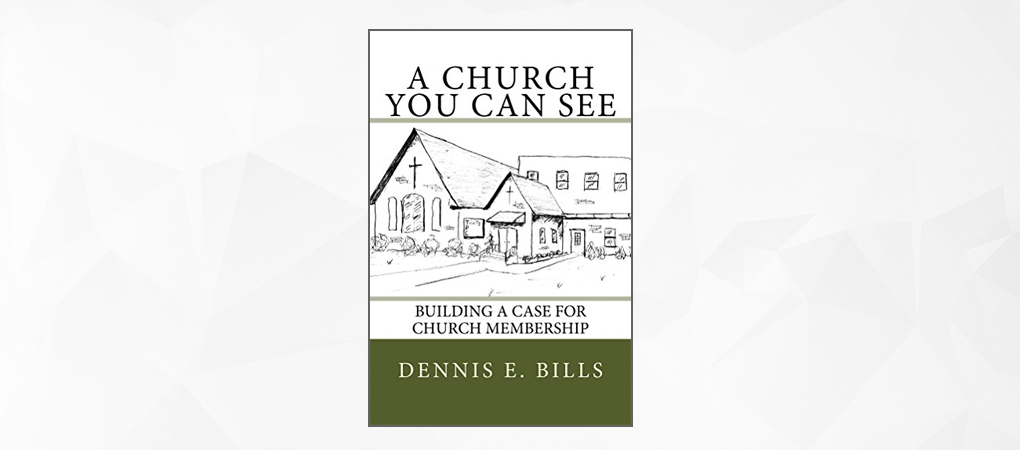Book Review: A Church You Can See, by Dennis Bills
April 18, 2019

April 18, 2019
Dennis Bills, A Church You Can See: Building a Case for Church Membership. CreateSpace, 2017. 121 pages.
By my count, I’ve noted at least six books published on the topic of church membership in the last fifteen years. So as I approached Dennis Bills’ new book, I couldn’t help but wonder, “Will this be worthy my time or just a restatement of others’ arguments?”
In A Church You Can See, Bills capably defends the Bible’s teaching that Christians should visibly commit to local churches. From the outset, he clarifies that this book is not an ecclesiology textbook for scholars but a simple, straightforward work for his “blue collar brothers and sisters” (vii). While his argument is simple, it is not simplistic. Bills builds his case for membership on the following three themes: union with Christ, expression of that union in a visible church, and commitment to a visible church.
Part one of the argument establishes that the foundation of church membership is union with Christ (6). Since all believers are united to Christ, they’re also naturally united to other believers (7–8). Most who object to church membership today would happily concede this point. So the author only treats it briefly.
Next, Bills highlights the similarities and differences between the visible and invisible church. This comparison and contrast exposes that the visible church and the invisible church significantly overlap, even though they are not the same. Practically speaking, this significant overlap means belonging to the invisible, universal church in some way demands belonging to the visible, local church. Bills contends, “No Christian can claim to be a part of the visible church without participating in the local church” (33).
Yet, as Bills notes, opponents to church membership might concede that the visible church is important but still not accept his or her responsibility to commit to a local church. Thankfully, the concluding chapters of the book torpedo such thinking by rehearsing the numerous Scriptural passages that demonstrate a Christian’s responsibility to commit to a church. Chapter six focuses on the believer’s biblical obligations to the church (49–63), while chapter seven focuses on the church’s obligations to its members. Thus, Bills argues, these obligations logically demand the a committed relationship—namely, church membership.
I sometimes feel like Goldilocks when looking for a book on church membership to give to folks in my church. “This one is too hard, that one is too soft. This one’s too deep, that one’s too shallow.” But A Church You Can See is just right. It provides a clear and compelling argument for church membership that’s accessible at every level. In our internet and social media age, biblical teaching is easily dispersed, yet the many consumers of that biblical content are refusing to submit themselves to a local church. Bills presents a great case for uniting to a local congregation and receiving biblical instruction with brothers and sisters who live in your same zip code.
And yet, I need to caveat my praise for Bills’ work. As a Baptist, there are few things in the book with which I disagree. Anyone familiar with the ecclesiological differences between Presbyterians and Baptists won’t be surprised by these criticisms. I’ll briefly mention a few.
First, Bills adheres to infant baptism which crops up occasionally throughout the book. For instance, in the first chapter he quotes from the Westminster Confession of Faith (25:2), which includes in its definition of the visible church “all those throughout the world that profess the true religion; and of their children” (8).
Second, while I appreciate his strong view of eldership, Bills takes the importance of elders a bit too far. He writes, “In short, I will make the case that if a ‘church’ does not have elders, then it is not a church” (37). A plurality of elders is, of course, prescribed in the New Testament and vital for the health of a congregation. Yet, a church can still exist without elders. In Matthew 18:15–20, Jesus grants the church, not just the elders, the authority to excommunicate unrepentant members. If elders are truly essential (not just important), were the believers scattered in various towns throughout Crete not a church until Titus came back through and appointed elders (Titus 1:5)? Defining a church in terms of elders as opposed to a congregation effectively fires the church from their job to carry out the responsibilities of membership.
Bills has crafted a worthwhile book on membership, especially for the regular attender who’s not convinced he needs to join your church but is open to searching the Scriptures. As Bills writes, “[The case for church membership] has relied far too long on tradition and utilitarianism. It has needed to ground membership in Scripture” (87). Bills indeed builds a biblical case for membership that is grounded in Scripture and accessible for all—Baptists and Presbyterians alike.